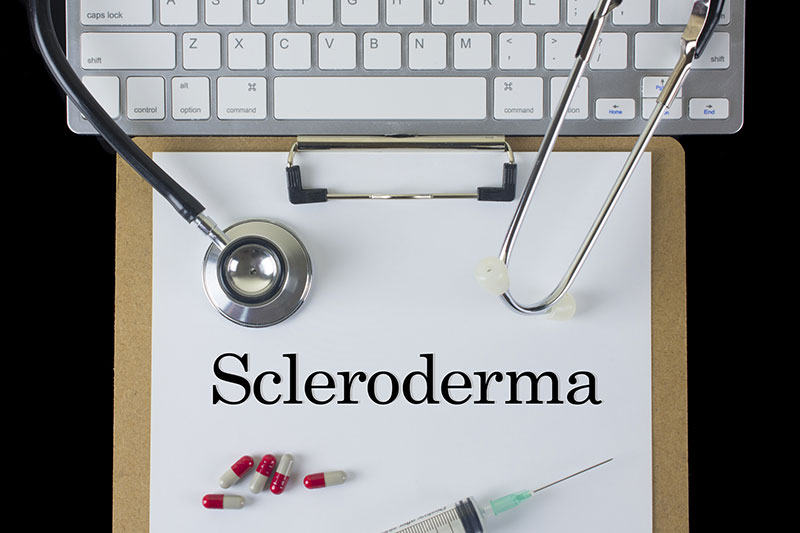Medical record review for social security disability benefits involves a comprehensive analysis of the claimant’s medical records to validate the claim. Scleroderma is an autoimmune disease that is included in the Social Security Administration’s (SSA) list of disabling conditions. A condition that affects the body’s connective tissue, some cases of scleroderma are localized to the skin resulting in tightening and hardening of the skin. More severe scleroderma affects other organs and body systems such as the heart, lungs, kidneys and digestive system. Symptoms of this condition include painful swelling of the joints, pain and numbness in the hands and feet, scarring/inflammation of the tissues in the lungs and esophagus and resultant pulmonary and digestive difficulties.
Medical Records and Medical Records Analysis Are Key Requirements
The SSA requires medical evidence that proves the claimant meets the Blue Book guidelines (listed in Section 14.00). A complete set of medical records needs to be submitted along with the disability application. These records must show that the scleroderma symptoms impair the applicant’s functionality to such an extent that they disable him/her from working. Apart from matching the definition listed in the Blue Book, the claimant must also have one of the following impairment combinations.
- Two areas of the body must be affected; one area must be severely impacted, OR
- The applicant must have two symptoms of severe illness that meet the SSA definitions.
If the applicant has chronic scleroderma that is not very severe, there should be medical records that show two symptoms of extreme illness, and also provide evidence that the claimant’s condition impacts his/her ability to function in normal daily activities as well as perform steady work.
If the claimant has a severe condition with regard to mobility (in the hands or feet), the medical records must show how the condition severely limits or completely prevents him/her from using the hands dexterously, or prevents him/her from walking.
When scleroderma affects more than one body system or organ, the medical records should have accurate documentation related to at least two of the following:
- Fever
- Malaise
- Fatigue
- Involuntary weight loss
Here is a look at some medical conditions which also require to be adequately documented in the medical chart.
- Contractures in the hands or feet: The claimant may be eligible for benefits if the records can prove that he/she has either toe contractures/deformities in one or both feet that prevent them from walking without an assistive device, Or
Finger deformities/contractures in both hands that prevent him/her from performing fine and gross movements such as holding a pen, lifting objects, sorting papers, or even tying the shoe.
- Raynaud’s Phenomenon: The claimant must have Raynaud’s Phenomenon with one of the following:
- Ischemia or lack of blood supply with open sores on the toes that prevent the claimant from walking without an assistive device
- Gangrene in at least two limbs such as the arms and/or legs
OR
- Ischemia with open sores on the fingers that prevent the claimant from performing fine and gross movements such as lifting objects, holding a pen, sorting papers, or tying his/her shoe.
- Atrophy in the arms or legs: The applicant must have one of the following limitations.
- Irreversible atrophy in one or both of the legs that prevents the claimant from walking without an assistive device, OR
- Irreversible atrophy in both arms that prevents the claimant from performing fine and gross movements like holding a pen, tying the shoe, lifting objects or sorting papers.
SSA’s Terminology for Key Info to Be Documented in the Medical Chart
- “Impairments” and Consequent “Limitations”: These include the nature of the disability and why the claimant cannot work. This information must be accurately documented in the medical chart by the treating physicians.
- Residual Functional Capacity (RFC): It is an important factor and is related to the physical and/or mental impairments that result from the particular conditions for which the disability claim is filed, and to the impact of the disability on the claimant’s ability to work. The SSA has Physical RFC form and Mental RFC form, which must be filled out by the treating physician who has examined the patient and has a clear understanding of the limitations that result from the disabling condition so that the medical aspects can be documented using terminology specific to SSA disability.
Just as for any other disabling condition, medical records and their review are key to winning a scleroderma claim as well. Disability attorneys can benefit from solutions such as medical record organization, review, and medical case summary provided by an experienced medical review firm.
This will expedite the review of voluminous medical documentation including lab test records, imaging records, scans for scleroderma, and all doctors’ notes that indicate the claimant’s symptoms, treatments undergone, and response to medical interventions. As an experienced provider of medical review services for attorneys, we assist social security disability attorneys in preparing the medical evidence needed to prove their clients’ disability so that eligible claimants receive the financial assistance they need.
———————————————————————————————————————————
Disclaimer: The content in this blog is meant for informative purposes only, and does not constitute professional legal opinion. Please contact an experienced disability attorney for a professional opinion.




